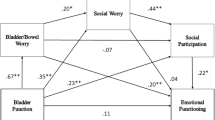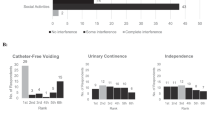Abstract
Study design:
Exploratory qualitative.
Objectives:
The aim of this study was to describe the experiences of bowel and bladder dysfunction on social activities and relationships in people with spinal cord injury living in the community.
Setting:
People living with spinal cord injury experiencing bowel and bladder dysfunction.
Methods:
Participants were recruited through the Australian Quadriplegic Association Victoria. Semi-structured in-depth interviews were undertaken with purposively selected participants to ensure representation of age, gender, spinal cord injury level and compensation status. A thematic analysis was performed to interpret patient experiences.
Results:
Twenty-two participants took part in the study. Bladder and bowel dysfunction altered relationships because of issues with intimacy, strained partner relationships and role changes for family and friends. A lack of understanding from friends about bladder and bowel dysfunction caused frustration, as this impairment was often responsible for variable attendance at social activities. Issues with the number, location, access and cleanliness of bathrooms in public areas and in private residences negatively affected social engagement. Social activities were moderated by illness, such as urinary tract infections, rigid and unreliable bowel routines, stress and anxiety about incontinence and managing the public environment, and due to continuous changes in plans related to bowel and bladder issues. Social support and adaptation fostered participation in social activities.
Conclusion:
Tension exists between managing bowel and bladder dysfunction and the desire to participate in social activities. Multiple intersecting factors negatively affected the social relationships and activities of people with spinal cord injury and bowel and bladder dysfunction.
Similar content being viewed by others
Log in or create a free account to read this content
Gain free access to this article, as well as selected content from this journal and more on nature.com
or
References
Barker RN, Kendall MD, Amsters DI, Pershouse KJ, Haines TP, Kuipers P . The relationship between quality of life and disability across the lifespan for people with spinal cord injury. Spinal Cord 2009; 472: 149–155.
Shaw C, Logan K, Webber I, Broome L, Samuel S . Effect of clean intermittent self-catheterization on quality of life: a qualitative study. J Adv Nurs 2008; 616: 641–650.
Guilcher SJT, Craven BC, Lemieux-Charles L, Casciaro T, McColl MA, Jaglal SB . Secondary health conditions and spinal cord injury: an uphill battle in the journey of care. Disabil Rehabil 2013; 3511: 894–906.
Callaway L, Barclay L, McDonald R, Farnworth L, Casey J . Secondary health conditions experienced by people with spinal cord injury within community living: implications for a National Disability Insurance Scheme. Aust Occup Ther J 2015; 624: 246–254.
Simpson LA, Eng JJ, Hsieh JTC, Wolfe DL Spinal Cord Injury Rehabilitation Evidence Research Team. The health and life priorities of individuals with spinal cord injury: a systematic review. J Neurotrauma 2012; 298: 1548–1555.
Hammell KRW . Spinal cord injury rehabilitation research: patient priorities, current deficiencies and potential directions. Disabil Rehabil 2010; 3214: 1209–1218.
Francis K . Physiology and management of bladder and bowel continence following spinal cord injury. Ostomy Wound Manage 2007; 5312: 18–27.
Fonte N . Urological care of the spinal cord–injured patient. J Wound Ostomy Continence Nurs 2008; 353: 323–331.
Hicken B, Putzke J, Richards S . Bladder management and quality of life after spinal cord injury. Am J Phys Med Rehabil 2001; 8012: 916–922.
Liu CW, Attar KH, Gall A, Shah J, Craggs M . The relationship between bladder management and health-related quality of life in patients with spinal cord injury in the UK. Spinal Cord 2010; 484: 319–324.
Pardee C, Bricker D, Rundquist J, MacRae C, Tebben C . Characteristics of neurogenic bowel in spinal cord injury and perceived quality of life. Rehabil Nurs 2012; 373: 128–135.
Naicker AS, Roohi SA, Naicker MS, Zaleha O . Bowel dysfunction in spinal cord injury. Med J Malaysia 2008; 632: 104–108.
Cameron AP, Wallner LP, Forchheimer MB, Clemens JQ, Dunn RL, Rodriguez G et al. Medical and psychosocial complications associated with method of bladder management after traumatic spinal cord injury. Arch Phys Med Rehabil 2011; 923: 449–456.
Craig A, Nicholson Perry K, Guest R, Tran Y, Middleton J . Adjustment following chronic spinal cord injury: determining factors that contribute to social participation. Br J Health Psychol 2015; 204: 807–823.
Burns AS, St-Germain D, Connolly M, Delparte JJ, Guindon A, Hitzig SL et al. Phenomenological study of neurogenic bowel from the perspective of individuals living with spinal cord injury. Arch Phys Med Rehabil 2015; 961: 49–55.
Engkasan JP, Ng CJ, Low WY . Factors influencing bladder management in male patients with spinal cord injury: a qualitative study. Spinal Cord 2014; 522: 157–162.
Nevedal A, Kratz AL, Tate DG . Women's experiences of living with neurogenic bladder and bowel after spinal cord injury: life controlled by bladder and bowel. Disabil Rehabil 2016; 386: 573–581.
Guilcher SJ, Casciaro T, Lemieux-Charles L, Craven C, McColl MA, Jaglal SB . Social networks and secondary health conditions: the critical secondary team for individuals with spinal cord injury. J Spinal Cord Med 2012; 355: 330–342.
Barclay L, McDonald R, Lentin P, Bourke-Taylor H . Facilitators and barriers to social and community participation following spinal cord injury. Aust Occup Ther J 2016; 631: 19–28.
Saunders LL, Krause JS, Focht KL . A longitudinal study of depression in survivors of spinal cord injury. Spinal Cord 2012; 501: 72–77.
Cohen S . Social relationships and health. Am Psychol 2004; 598: 676–684.
Ritchie J, Spencer L . Qualitative data analysis for applied policy research. In: Bryman A, Burgess R (eds) Analyzing Qualitative Data. Routledge: London, UK. 1994, pp 173–194.
Koch T, Kralik D, Kelly S . We just don't talk about it: men living with urinary incontinence and multiple sclerosis. Int J Nurs Pract 2000; 65: 253–260.
Burns A St, Germain D, Connolly M, Delparte J, Guindon A, Hitzig S et al. Neurogenic bowel after spinal cord injury from the perspective of support providers: a phenomenological study. PM R 2015; 74: 407–416.
Van De Ven L, Post M, De Witte L, Van Den Heuvel W . Strategies for autonomy used by people with cervical spinal cord injury: a qualitative study. Disabil Rehabil 2008; 304: 249–260.
Logan K, Shaw C . Intermittent self-catheterization service provision: perspectives of people with spinal cord injury. Int J Urol Nurs 2011; 52: 73–82.
Hammel J, Magasi S, Heinemann A, Gray DB, Stark S, Kisala P et al. Environmental barriers and supports to everyday participation: a qualitative insider perspective from people with disabilities. Arch Phys Med Rehabil 2015; 964: 578–588.
Munce SE, Webster F, Fehlings MG, Straus SE, Jang E, Jaglal SB . Perceived facilitators and barriers to self-management in individuals with traumatic spinal cord injury: a qualitative descriptive study. BMC Neurol 2014; 14: 48.
Price P, Stephenson S, Krantz L, Ward K . Beyond my front door: the occupational and social participation of adults with spinal cord injury. OTJR 2011; 312: 81–88.
Dickson A, Ward R, O'Brien G, Allan D, O'Carroll R . Difficulties adjusting to post-discharge life following a spinal cord injury: an interpretative phenomenological analysis. Psychol Health Med 2011; 164: 463–474.
Australian Human Rights Commission. A brief guide to the Disability Discrimination Act: Australian Human Rights Commission; 2016 [cited 13 April 2016]. Available from: https://www.humanrights.gov.au/our-work/disability-rights/guides/brief-guide-disability-discrimination-act.
Wilde MH, Brasch J, Zhang Y . A qualitative descriptive study of self-management issues in people with long-term intermittent urinary catheters. J Adv Nurs 2011; 676: 1254–1263.
Vaidyanathan S, Soni BM, Singh G, Oo T, Hughes P . Barriers to implementing intermittent catheterisation in spinal cord injury patients in Northwest Regional Spinal Injuries Centre, Southport, UK. ScientificWorldJournal 2011; 11: 77–85.
Cohen S, Wills TA . Stress, social support, and the buffering hypothesis. Psychol Bull 1985; 982: 310–357.
Ljungberg I, Kroll T, Libin A, Gordon S . Using peer mentoring for people with spinal cord injury to enhance self-efficacy beliefs and prevent medical complications. J Clin Nurs 2011; 203-4: 351–358.
Livneh H, Martz E . Coping strategies and resources as predictors of psychosocial adaptation among people with spinal cord injury. Rehabil Psychol 2014; 593: 329–339.
Shaw C, Logan K . Psychological coping with intermittent self-catheterisation (ISC) in people with spinal injury: a qualitative study. Int J Nurs Stud 2013; 5010: 1341–1350.
Coggrave M, Norton C, Cody JD . Management of faecal incontinence and constipation in adults with central neurological diseases. Cochrane Database Syst Rev 2014; 1: CD002115.
Adriaansen JJ, Post MW, De Groot S, Van Asbeck FW, Stolwijk-Swuste JM, Tepper M et al. Secondary health conditions in persons with spinal cord injury: a longitudinal study from one to five years post-discharge. J Rehabil Med 2013; 4510: 1016–1022.
D'Hondt F, Everaert K . Urinary tract infections in patients with spinal cord injuries. Curr Infect Dis Rep 2011; 13: 544–551.
Jensen MP, Truitt AR, Schomer KG, Yorkston KM, Baylor C, Molton IR . Frequency and age effects of secondary health conditions in individuals with spinal cord injury: a scoping review. Spinal Cord 2013; 5112: 882–892.
Acknowledgements
We thank Peter Trethewey and express our appreciation to the participants. This project is funded by the Transport Accident Commission through the Institute for Safety, Compensation and Recovery Research. BG was supported by a Career Development Fellowship (GNT1048731) from the National Health and Medical Research Council (NHMRC) of Australia.
Author information
Authors and Affiliations
Corresponding author
Ethics declarations
Competing interests
The authors declare no conflict of interest.
Rights and permissions
About this article
Cite this article
Braaf, S., Lennox, A., Nunn, A. et al. Social activity and relationship changes experienced by people with bowel and bladder dysfunction following spinal cord injury. Spinal Cord 55, 679–686 (2017). https://doi.org/10.1038/sc.2017.19
Received:
Revised:
Accepted:
Published:
Issue date:
DOI: https://doi.org/10.1038/sc.2017.19
This article is cited by
-
Verification of a system utilizing heartbeat-induced acoustic pulse waves for estimating the time at which bladder urine increases to a level requiring drainage among individuals with spinal cord injury
BioMedical Engineering OnLine (2024)
-
Priorities, needs and willingness of use of nerve stimulation devices for bladder and bowel function in people with spinal cord injury (SCI): an Australian survey
Spinal Cord Series and Cases (2024)
-
Experiences of people with spinal cord injuries readmitted for continence-related complications: a qualitative descriptive study
Spinal Cord (2024)
-
Social Ecology of Neurogenic Lower Urinary Tract Dysfunction
Current Bladder Dysfunction Reports (2024)
-
Bladder and bowel function effects on emotional functioning in youth with spinal cord injury: a serial multiple mediator analysis
Spinal Cord (2023)



